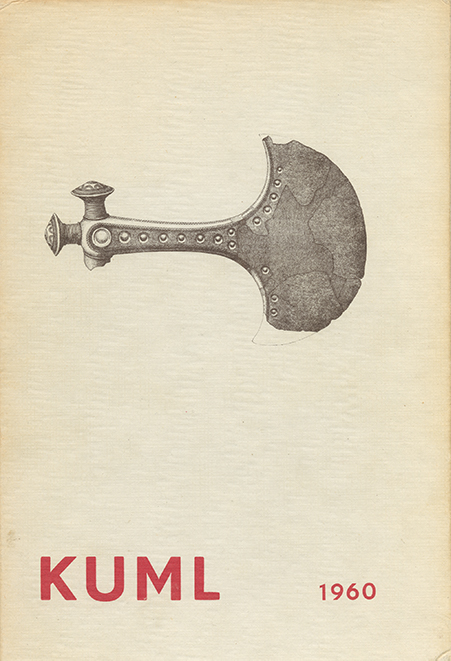Brandstrup
DOI:
https://doi.org/10.7146/kuml.v10i10.103109Nøgleord:
brandstrup, cavalry grave, ryttergrav, spillebræt, gamesboard, 10th century, 10 århundredeResumé
Brandstrup. A 10th Century Cavalry Grave
In the village of Brandstrup in Viborg County a man's grave from the 10th century A.D. was excavated in October 1953. The grave lay under a level surface and, when the topsoil had been removed, could be seen as an excavation measuring 4.62 by 2.70 metres, covered with an irregular layer of stones, and with its longest axis pointing NNE-SSW (fig. 1). The funerary furnishings were discovered on the bottom of the grave, which lay about 1,25 meters under the surface (fig. 2). They consisted of, in the south, the leg-bones of a horse; in the centre of the east side, a heap of metal objects belonging to the harness; in the centre of the grave, a pair of spurs with buckles, a pair of shears and a little knife; to the north of these, a sword and a little belt fitment; to the west of these, some smaller objects and fragments, including a rectangular piece of iron, 11.5 cms. long, in which 3 silver coins were later found embedded, a wooden knife-handle, and a whetstone; finally in the west side of the grave, counting from the south, lay the iron handle to a now lost bucket, the remains of what is considered to have been a games-board of wood, and a spearhead.
The sword (fig. 3) is 1 metre long. The pommel and the hilt bear silver inlay while the blade is covered with rust and the remains of the wooden scabbard. Traces of fine cloth were preserved towards the bottom of the scabbard 1). So far as the state of preservation permits a determination, the sword should be ascribed to Jan Petersen's Type S 2).
The spearhead (fig. 4) is 53 cms. long, and has a flat blade without rib. It lies close to Jan Petersen's Type G 4).
The bit (fig. 5) is a bar-bit with a two-link mouthpiece ending in two lugs set at rightangles. Traces of silver can be seen on one of the side-bars. Two cheek-pieces, which only survived in fragments, had been silver-plated. In the outer lugs of the mouthpiece a pair of double rings had hung, and around one of these lay a fragment of a strap with impressed ornamentation, 1.4 cms. broad (fig. 6) Fragments of the same strap were preserved in connection with tongue-shaped fitments to fit straight-edged strap ends. A number of small silverplated fitments of lead had ornamented the harness. They correspond closely to the fitments from the Stengade grave 3 7).
The stirrups (figs. 7---8)) are 23 and 24 cms. high, and are of the normal 10th century type with pointed arches. The broad strap-connection was attached by three bands of metal to a fitment lying parallel with the strap-connection (reconstruction Fig. 9). Both stirrups are ornamented with silver and copper inlay, in such a way that the copper originally formed a background to the variagated ornamentation of silver. The same motifs are used, in various combinations, on both stirrups. They consist of spiral tendrils, interlaced bands, ladder and meander bands, and a band edged with rows of curves. A little fir-twig motif is used as a space-filler.
The spurs (fig. 11) have a long round rowel in the same plane as the arms. Remains of ornamentation in silver covering the whole surface survive on one of the spurs, and consist of fields of zigzag lines laid close together and running along the spur, interrupted by cross-lines.
The assumed gamesboard (fig. 13) measures 30 by 60 cms., and is divided into two parts of equal size, with a ribbon-shaped conneeting fitment of metal. The edges are covered by four corner fitments, a ribbon-shaped fitment along one end, and nails with round flat heads along the other end and the two sides.
The three silver coins (fig. 14) are all of the same type, Hedeby half-bracteates from the middle of the 10th eentury 18).
The dating of the grave to the 10th century is clearly indicated by the inventary. The ornamentation of the stirrups - confirmed by the coins - points to the second half of the century. Cavalry graves are fairly common in that century, and armament consisting of sword and spear is typical for such graves, in contrast with other men's graves, where the axe is the normal weapon.
Brandstrup Il.
In the course of a subsequent investigation in 1956 another grave was found about 10 metres east of the cavalry grave. It appeared as an irregular pit lying north-south, 2.70 metres long and surviving width about 1 metre (the west side of the grave having been dug away). At a depth of about 80 cms. the pit narrowed to a length of 2 metres and a width of 60 cms. At the edge of this inner excavation, which is assumed to be the actual grave, had been placed a handled vessel, 6.5 cms. tall and variegated black and brown in colour. This is of earlier date than the cavalry grave, possibly from the end of the Roman lron Age.
Jytte Lavrsen.Downloads
Publiceret
Citation/Eksport
Nummer
Sektion
Licens
Fra og med årgang 2022 er artikler udgivet i Kuml med en licens fra Creative Commons (CC BY-NC-SA 4.0).
Alle tidligere årgange af tidsskriftet er ikke udgivet med en licens fra Creative Commons.


